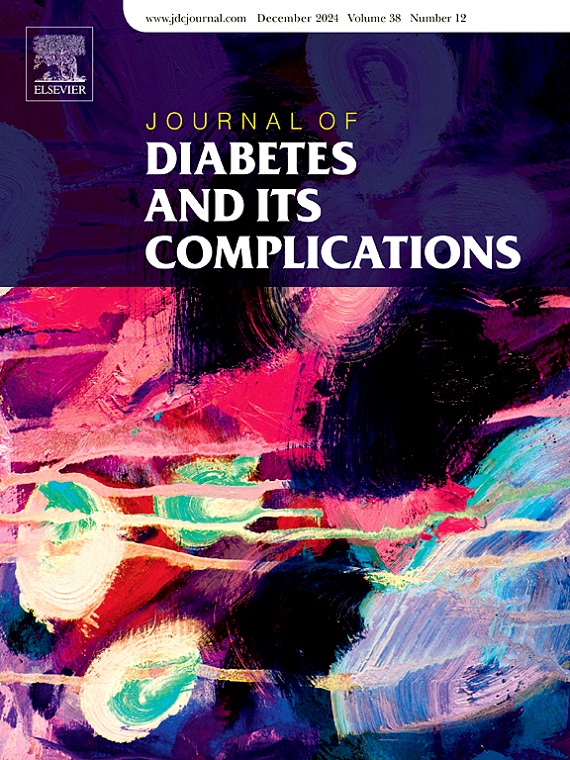2型糖尿病的脑血流动力学和氧合受损:胰岛素抵抗和高血糖的影响
IF 3.1
3区 医学
Q3 ENDOCRINOLOGY & METABOLISM
引用次数: 0
摘要
目的:越来越多的证据表明,2型糖尿病(T2D)可能对脑血流动力学和脑氧合产生不利影响。本研究旨在探讨单纯T2D对最大运动时脑血流动力学和氧合的影响。方法在一项比较临床试验中,入选30对匹配的肥胖受试者,按T2D状态分层。在增量最大运动时评估血流动力学和氧合参数。此外,还评估了身体活动水平、血脂和胰岛素抵抗指标。结果与对照组相比,T2D患者的脑血容量(总血红蛋白)和氧合(含氧血红蛋白)明显受损,特别是在运动强度超过vo2峰值的80%时。这种损伤与运动峰值时两组动脉二氧化碳分压(PaCO2)水平的差异无关。PaCO2 34.4±3.2 vs 34.5±1.3 mmHg)。此外,与对照组相比,T2D患者的估计葡萄糖处置率(eGDR)更低(P = 0.02;7.4±2.4 vs 9.27±0.97 mg/kg/min)。结论t2dm患者胰岛素抵抗和高血糖可导致血流动力学和脑氧合功能受损,甚至在微血管病变出现临床症状之前就已发生。这些改变可能对T2D患者的认知功能和整体大脑健康有重大影响。registrationPACTR202301667050563审判。本文章由计算机程序翻译,如有差异,请以英文原文为准。
Impaired cerebral hemodynamics and oxygenation in type 2 diabetes: insights into insulin resistance and hyperglycemia effects
Aims
Emerging evidence suggests Type 2 diabetes (T2D) may adversely affect cerebral hemodynamics and oxygenation. This study aimed to explore the impact of uncomplicated T2D on cerebral hemodynamics and oxygenation during maximal exercise.
Methods
In a comparative clinical trial, 30 matched pairs of subjects with obesity, stratified by T2D status, were enrolled. Hemodynamic and oxygenation parameters were assessed during incremental maximal exercise. Additionally, physical activity levels, lipid profiles, and insulin resistance markers were evaluated.
Results
Participants with T2D exhibited significantly impaired cerebral blood volume (total hemoglobin) and oxygenation (oxygenated hemoglobin) compared to controls, especially at exercise intensities above 80 % of VO2peak. This impairment was independent of differences in arterial carbon dioxide partial pressure (PaCO2) levels between the groups at peak exercise (P > 0.05, PaCO2 34.4 ± 3.2 vs 34.5 ± 1.3 mmHg). Moreover, individuals with T2D had a lower estimated glucose disposal rate (eGDR) compared to the control group (P = 0.02; 7.4 ± 2.4 vs 9.27 ± 0.97 mg/kg/min).
Conclusions
Our findings indicate that insulin resistance and hyperglycemia in T2D contribute to impaired cerebral hemodynamics and oxygenation, even before clinical signs of microangiopathy appear. These alterations could have significant implications for cognitive function and overall brain health in individuals with T2D.
Trial registration
PACTR202301667050563.
求助全文
通过发布文献求助,成功后即可免费获取论文全文。
去求助
来源期刊

Journal of diabetes and its complications
医学-内分泌学与代谢
CiteScore
5.90
自引率
3.30%
发文量
153
审稿时长
16 days
期刊介绍:
Journal of Diabetes and Its Complications (JDC) is a journal for health care practitioners and researchers, that publishes original research about the pathogenesis, diagnosis and management of diabetes mellitus and its complications. JDC also publishes articles on physiological and molecular aspects of glucose homeostasis.
The primary purpose of JDC is to act as a source of information usable by diabetes practitioners and researchers to increase their knowledge about mechanisms of diabetes and complications development, and promote better management of people with diabetes who are at risk for those complications.
Manuscripts submitted to JDC can report any aspect of basic, translational or clinical research as well as epidemiology. Topics can range broadly from early prediabetes to late-stage complicated diabetes. Topics relevant to basic/translational reports include pancreatic islet dysfunction and insulin resistance, altered adipose tissue function in diabetes, altered neuronal control of glucose homeostasis and mechanisms of drug action. Topics relevant to diabetic complications include diabetic retinopathy, neuropathy and nephropathy; peripheral vascular disease and coronary heart disease; gastrointestinal disorders, renal failure and impotence; and hypertension and hyperlipidemia.
 求助内容:
求助内容: 应助结果提醒方式:
应助结果提醒方式:


